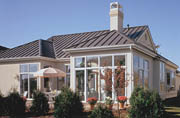Changing the Face of Metal

According to Tom Black, executive director of the Metal Roofing Alliance (MRA), Gig Harbor, Wash., increasing numbers of homeowners are choosing metal roofs — approximately 300,000 homes were garnished with them last year alone.
“Metal roofing is increasing at a fairly rapid rate in the market,” Black explains. “Whereas the overall growth of the roofing market is a long-term steady growth, metal is growing, we believe, in the high teens to 20 percent.”
Metallic Misconceptions
However, Black says that despite the increase in residential installations, “There still are a lot of misconceptions about metal in the consumers’ minds.” Because customers are often unsure about the product, he claims, “One of the biggest obstacles is lack of consumer awareness.”Lack of awareness can give birth to a myriad of other obstacles regarding metal, as well. For example, contractor Mike Smith, owner of Wheatland Roofing Inc., Regina, Saskatchewan, Canada, claims that many of his customers have a difficult time getting past the stereotype that metal roofs belong on barns, not houses. “Corrugated roofing is quite prominent in the agricultural community,” Smith says, “so when you mention metal roofing, the image is barn metal. We’ve worked hard to overcome that image.”
Since metal roofs are more expensive than traditional asphalt or fiberglass installations, convincing homeowners that the metal is worth the extra cost is another hurdle contractors must scale, according to Mitch Hentkowsky of Allwine Roofing and Construction, Tulsa, Okla. “Cost is the biggest obstacle we face,” he explains. “From day one until today, we have a lot of people who want metal, and then you tell them the cost, and they say, ‘Oh, I can’t afford that.’”
Michael Adler, a contractor from Joliet, Ill., agrees that price often keeps homeowners from installing metal roofs. Most of the people who approach his company, J.L. Adler Roofing and Sheet Metal Inc., “are very aware of the product,” he says. “However, they don’t know if they’re ready to make the decision to install it. I’d say the biggest deterrent right now is the cost of the product.”
Demystifying Metal
To combat these obstacles and increase public awareness about metal roofing, the MRA and contractors are taking the initiative and working hard to educate consumers about the benefits of metal roofing.“As an industry, we’re providing a top-notch product, and the customer is constantly searching for quality,” Smith explains. “An educated customer is definitely to our advantage. I think the more information we give to the customer in regards to metal roofing, the better.”
Hentkowsky agrees and says that in his experience, homeowners who have studied metal roofs are more likely to purchase them, regardless of higher costs. “The metal roof sells itself to people who have researched it and know something about it. They understand the costs and benefits of it better,” he says.
According to Hentkowsky, one of the easiest ways to educate consumers and debunk myths surrounding metal is simply to expose customers to metal roofs, whether by giving them literature or physically showing them a house with a metal roof. “There is more literature about metal out there. There are more articles in magazines. There are more people getting metal roofs on their houses so people actually see them,” he says. “You generate a lot of interest in a product this way.”
Another simple way to educate homeowners is to sit down and explain metal’s advantages to them. Adler explains his company’s strategy by saying, “What we’re trying to do is focus mainly on the benefits. We talk about the long-term durability of the product, the appearance of it, and how well it holds up, even in our conditions here in the Midwest.”
The MRA (www.metalroof.org) and individual contractors use the Internet to market and teach consumers about residential metal, as well. For example, the Website for Smith’s company, www.wheatlandroofing.com, explains the benefits and answers to commonly asked questions about metal roofing. “As far as the Internet is concerned, that’s become more popular and is a very good sales tool for us,” Smith says.
Contractors also use advertising initiatives to increase consumer awareness and augment metal’s popularity. The MRA, which was created in 1998 to promote the use of residential metal, spearheads many of these projects.
One MRA-sponsored advertisement is a television commercial designed to promote the aesthetics of metal roofing. With the MRA’s help, Smith is one contractor who used that commercial to his advantage. “We tagged our logo and phone number to the back end of the commercial, and ran it on our most popular local television station,” Smith explains. “We received excellent results — from last year alone, I would estimate we received 75 to 100 direct leads. It’s a very powerful tool that changes the image of metal roofing.”
Other companies like Luebke Roofing, a division of the Ribble Group, Kaukauna, Wis., use marketing initiatives to transform the way people think about the higher cost of metal. General manager Jon Goodman explains, “Price is never an obstacle for us because of the way we market and position ourselves. We offer a high-end service, high-end treatment, high-end product. First you get the acceptance of the concept, then its acceptance as a value. That’s the hurdle. Once you start to build momentum and get that value recognition established, you’re on your way.”
Bright Future Ahead
The obstacles surrounding residential metal seem not to have abated contractors’ enthusiasm for the product. “I truly enjoy selling metal roofing because I feel we are providing our customers the best possible roofing product on the market,” Smith says. “As a business owner, the potential for a higher profit margin is attractive, as well. If sold and marketed properly, roofing contractors should expect a much higher rate of return as compared to other roofing products.”Similarly, contractors anticipate a strong year for residential metal in 2001. Adler, who installs shake panels with a batten strip, says he believes new products will help bring the cost of installations down in the future. “I believe some changes are being made to ease the installation so the product can still be as expensive as it is, but there are ways to install it easier. I see that coming up with the introduction of the panel that has a batten strip built into it — it’s more of a one-step process. I look forward to doing one of those installations,” he says.
Goodman agrees that new products could help save money on labor, therefore making installations less expensive. “We’re looking at shingle-style steel roofing. It’s a lower profile, more cost competitive, batten-less system that should allow us to go in and be competitive with the high-end laminated asphalt shingle market,” Goodman explains. “When you’re only putting on 15 pieces of metal per square, as opposed to putting on 100 pieces of something else, the labor savings start to come around.”
Goodman, who predicts slow and steady market growth, also says he hopes that both insurance agencies and architects help promote residential metal in the future. “If the insurance people would put their money where their mouths are and actually come up with some savings on premiums for metal roofing … that would be a great incentive,” Goodman says. “Already it’s helping that architects are starting to spec this on larger residential projects.”
Ultimately, though, the future of residential metal is in the consumers’ hands. Adler says he can see that homeowners are becoming much more curious about the product, and he anticipates that the product’s popularity will increase. “I know that there’s much more interest in metal than there was this time last year,” he says. “I’m quoting the product more, and people are interested in looking at the product, so we’re just trying to keep up with sending information out the door.”
Links
Looking for a reprint of this article?
From high-res PDFs to custom plaques, order your copy today!




